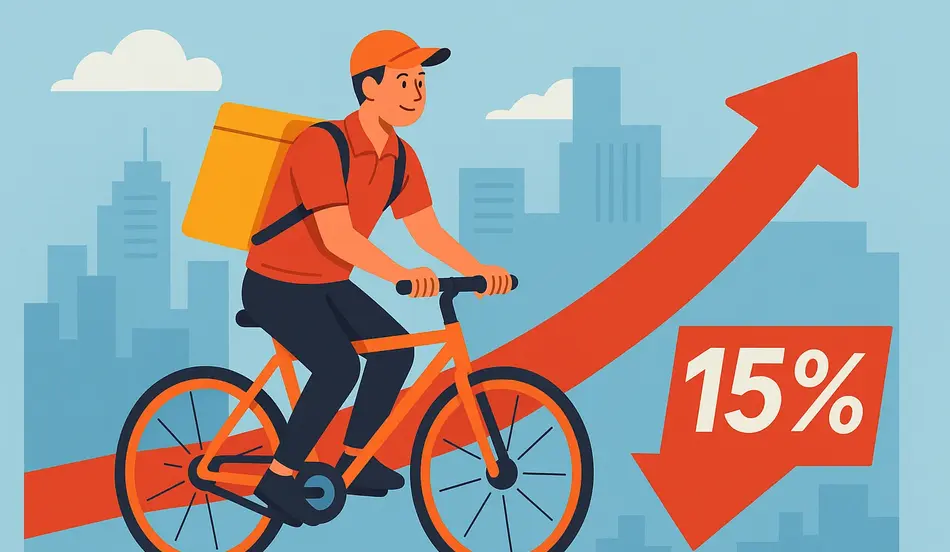The U.S. gig economy continues its rapid expansion in 2025, with on-demand delivery roles—spanning food, groceries, and parcel services—up 15% year-over-year. Fueled by consumer demand for instant convenience and sustained by flexible work preferences, these jobs are reshaping last-mile logistics, labor markets, and workforce policy. As platforms vie for couriers, understanding the drivers, benefits, and challenges of this surge is critical for workers, policymakers, and businesses alike.
Surge in Delivery Demand
Over the past twelve months, major delivery platforms have collectively added hundreds of thousands of driver and courier shifts each week. Data from the U.S. Bureau of Labor Statistics shows:
- Food delivery apps (DoorDash, Uber Eats, Grubhub) saw active driver numbers rise by 18%.
- Grocery delivery services (Instacart, Shipt) expanded their shopper bases by 22%.
- Parcel and retail logistics platforms (Amazon Flex, UPS On-Demand) increased gig-driver sign-ups by 12%.
This overall 15% gain reflects record consumer spending on delivery services, which grew by 11% in 2024 and is projected to grow another 10% in 2025 .
Key Growth Drivers
Convenience Culture
In a world of busy schedules, consumers value having meals, groceries, and even everyday household items delivered in under an hour. The ongoing popularity of subscription-based delivery memberships (e.g., DashPass, Instacart+), which bundle unlimited deliveries for a flat fee, has entrenched on-demand behavior.
Flexible Work Preferences
Post-pandemic surveys show that over 40% of gig workers appreciate the autonomy to choose hours and neighborhoods—allowing parents, students, and part-timers to earn on their own schedules. The ability to “go online” at will remains a powerful draw.
Platform Incentives
To meet demand spikes, platforms have rolled out sign-on bonuses, peak-hour surge pay, and referral incentives. In markets like Los Angeles and Chicago, guaranteed-earnings programs have lured couriers with daily minimums of $200–$250 for full-day availability.
Platforms in Competition
While DoorDash and Uber Eats dominate meal delivery with over 70% combined market share, newer entrants and niche players are seeking differentiation:
- GoPuff focuses on micro-fulfillment by stocking its own small warehouses for ultra-fast delivery of snacks and essentials.
- Postmates 2.0 (under Uber) is repositioning as a multi-category on-demand courier, blending food, retail, and pharmacy runs.
- Amazon Flex continues expanding its pool of independent drivers to handle Prime Now and Fresh orders in major metros.
Competition has driven platforms to increase per-delivery payouts, with average earnings per completed food order rising from $6.50 to $7.20 (before tips) over the last year .
Worker Perspectives
Many couriers report that the ability to set their own hours is life-changing. Sarah, a part-time college student in Atlanta, says, “I schedule dashes around my classes and earn $25–$35/hour on busy evenings. It’s better than any on-campus job.” Meanwhile, Marcus, a former warehouse associate in Dallas, finds that platform bonuses allow him to make in a single shift what he once earned in two.
However, the upsides come with trade-offs:
- Income Volatility: Earnings can fluctuate with demand, weather, and platform algorithm changes.
- Expense Burdens: Couriers cover fuel, vehicle maintenance, and insurance, which can consume 20–30% of gross earnings.
- Lack of Benefits: Independent contractors lack traditional protections—healthcare, unemployment, or workers’ compensation.
Regulatory and Policy Challenges
As on-demand delivery grows, so do calls for updated labor policies:
- Classification Debates: Cities like Seattle and New York have introduced ordinances guaranteeing minimum earnings and expense reimbursements for gig workers.
- Collective Bargaining: Some delivery couriers are organizing “app-based unions” or cooperatives to negotiate better rates and conditions.
- Data Transparency: Advocates urge platforms to disclose dispatch algorithms and pay-calculation methods to ensure fairness.
Federal legislative efforts have stalled, but several states are piloting portable benefits funds—collecting small fees per transaction to fund healthcare, retirement accounts, or paid leave for gig workers.
Need Couriers or Gig Workers Fast?
Reach flexible, motivated workers ready to deliver results. From students to full-time earners, thousands are actively searching for courier and gig opportunities on WhatJobs every day. Post your job today and connect with reliable talent in minutes.
Post a Job NowBusiness Impacts and Innovation
Brands and retailers rely on on-demand delivery to capture sales that would otherwise walk out the door. A national restaurant chain reports that 35% of its orders now come via third-party apps. Grocery retailers integrating Instacart and own-brand delivery services see average basket sizes increase 12% versus in-store purchases .
To manage costs and meet service promises, companies are experimenting with:
- Micro-fulfillment Centers: Automating order picking within small urban warehouses to speed packing.
- Predictive Dispatching: Using AI to forecast demand spikes and pre-position drivers.
- Drone and Robot Delivery Trials: Pilots in suburban markets aim to defray human-labor costs and improve safety.
Future Outlook
Industry analysts project on-demand delivery to continue growing at a 10–12% CAGR through 2027. Key trends to watch:
- Consolidation: As margins tighten, expect mergers among mid-tier platforms seeking scale.
- Subscription Growth: Bundled delivery memberships will proliferate beyond food to include retail and healthcare.
- Sustainability Focus: Shared-fleet electric vehicles and cargo-bike programs will expand in dense urban cores to reduce emissions.
- Augmented Worker Tools: Real-time earnings dashboards, route-optimization apps, and in-app training modules will enhance courier productivity and satisfaction.
Best Practices for Couriers
To maximize earnings and job satisfaction:
- Track Expenses Meticulously: Use mileage-tracking apps and maintain receipts to claim tax deductions.
- Strategize Work Hours: Identify peak times (e.g., lunch 11–2pm, dinner 5–9pm) and platform-driven surge windows.
- Multi-Platform Stints: Sign in to two apps simultaneously (e.g., Uber Eats plus Doordash) to capitalize on whichever pings arrive first.
- Cultivate Tip Income: Provide excellent service—prompt, courteous, and professional—to increase customer tipping rates.
FAQs
Q: How much can delivery couriers earn in 2025?
A: Average gross earnings range $20–$30/hour depending on market and platform incentives, before expenses and taxes.
Q: Do gig delivery jobs offer benefits?
A: As independent contractors, couriers generally lack employer-provided benefits, though portable benefits pilots in some states are emerging.
Q: Is demand growth slowing after pandemic peaks?
A: Growth has moderated from early-2020 heights but remains strong—15% year-over-year—driven by habitual consumer behavior and expanding service categories.
Q: Can delivery work be full-time?
A: Yes. Many couriers treat it as a primary income source, though they must manage volatility and costs proactively.




